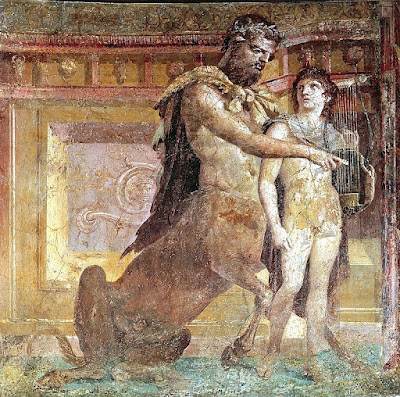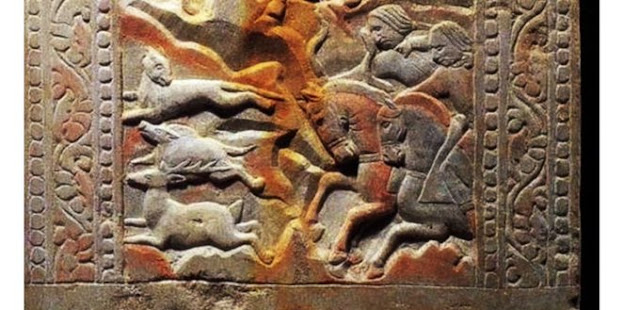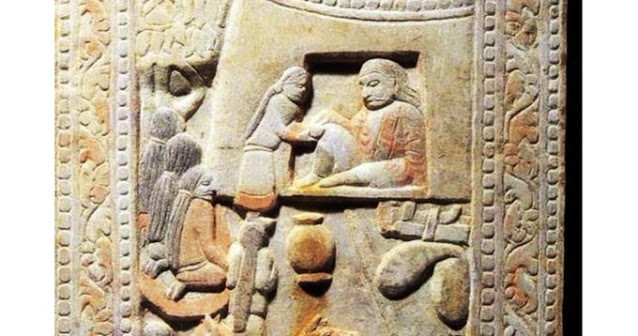 |
| Turkic-Tombstone-Central Asia-(by wiki) |
*
Tomaşek'in kitabına devam. Aşağıda kitapta geçen birkaç notla, wiki'de bulduğum Eski Türklere ait bir mezar taşını karşılaştıracağım. Başlayayım: İlkin Türk'ün mezar taşı. Bakın. Benim gördüğümü yorumlayayım: Ölen önemli kişi Adamları var Atları var Atlarıyla ava çıkıyor
*
Continue to Wilhelm Tomaschek's book.
I will compare a few notes in the book with a tombstone belonging to the Ancient Turks (above) that I found on the wiki.
Let me begin: Tombstone of Central Asian Türks.
Look at the pic.
Let me interpret what I see:
The dead Türk was an important person.
He had man and horses
He was going hunting with his horses
*
Tomaşek diyor ki: Traklar (birine) ad verirken at'ın rolü büyüktü. Nasıl anlayalım?. 'Daha sonra göstercem', diyor. Bakalım.
Atın önemi Traklarda büyük, diyor özetle. Ölen Türk'ün mezar taşında da ölenin atlarını ve at bakıcısını görürüz. Atın önemi iki millette de benzer.

Tomaschek Wilhelm - die alten Thraker - page about Thracians in general
*
Tomashek says: The horse played a big role in naming (someone) the Thracians.
How can we understand it?. 'I'll show you later,' he says. Let's see later.
The importance of the horse is great in the Thracians, he says in a nutshell.
On the gravestone of the deceased Turk, we see the deceased's horses and the horse caretaker. The importance of the horse is similar in both nations Turks and Thracians.
*
Şu sayfada bir bilgi daha var ki, tartışmaya açık. 'Aryanlarda ve Yunanlılarda olduğu gibi,...Traklarda da atın önemi büyüktü.'
Yunanlılarda atın önemi büyük olsaydı, yarı at yarı insan mitik kentaur icad ederler miydi? Etrüskler Truvalıyı atlı, Aşil'i atsız çizer miydi?
 |
| Centaur / Kentaur |
 |
| Greek hero Achilles without a horse, Trojan hero Troilus wit a horse |
There is one more piece of information on this page that is open to discussion.
'As with the Aryans and the Greeks... the horse was of great importance to the Thracians.' Hmm, really, that with Greeks and horses?
If the horse was of great importance to the Greeks, would they have invented a half-horse, half-human mythical centaur?
Would the Etruscans have drawn Trojan Troilus with a horse and Achilles without a horse?(ambush scene above).
*
Aynı sayfada kalıyoruz. Tomaşek diyor ki: Trakların en büyük hobileri/zevkleri atla ava çıkmaktır. Ölen Türk de aynı zevke/hobiye sahipmiş ki, bunu mezar taşına kazıtmış yakınları. Domuz ve geyik avlıyor arkadaşları/adamları ve itiyle. Bu da bir benzerliktir.
We stay on the same page.
Tomashek says: Thracians' biggest hobbies/pleasures are hunting with horses.
The deceased Turk on the tombstone had the same taste/hobby that his relatives had it engraved on his tombstone.
He hunts pigs and deer with his friends/men and his dog. This is also a similarity.
*
Tomaşek 115. sayfada Trakların saçlarından bahseder.
'..uzun saçlarını arkaya doğru tararlar ve bağlı veya bağsız omuzlarına salarlar...' Aşağıdaki mezar taşında bunu hemen görürüz.
Yooo, o zamanlar her halk saç uzatmıyor. Hiç saç uzatanlarla saç uzatmayanlar bir olur mu?
Tomaschek mentions Thracian hair on page 115: '..they comb their long hair back and hang it over their shoulders, with or without tie...'
We see this immediately on the tombstone above, too.
Nooo, not all peoples hat long hair at those times.
There is a Turkic war-scene you see on the last pic above, long haired Turks on the right against short haired enemy.
*
Yukarıdaki son görselde uzun saçlı Türkler kısa saçlı düşmanlarıyla çatışırken. Tomaşek kıyafetinden de bahseden Traklar'ın. Uzun kollu mantolar (Kittel=tunik) giyerler. (Almanca Kittel=önden açılan elbise demektir). Mezar taşındaki kıyafet bu tanıma uygundur. 3. görsel daha açıklayıcı

Thomaschek writes about the dress/Waffenrock of the Thracians
 |
| Türk dress versus Thracian dress |
In the last image above, long-haired Turks clash with their short-haired enemies.
The Thracians, who also mentioned the Tomashek outfit. They wear long sleeved coats (Kittel = tunic). German Kittel=means front opening long dress, like one of a doctor).
The dress on the tombstone fits this description.
3rd image is more descriptive!
*
Bence benim yularıdaki karşılaştırmalarım hiç de abartı değil ve kesindir ki her millet o zamanlar saçlar, elbiseler ve adetler bakımından aynı değil.
Karşılaştırmamdaki Traklar ve Türkler birbirinin aynı.
I think my above comparisons are not an exaggeration at all, and it is certain that not every nation was the same in hair, dress and customs at that time.
Thracians and Turks in my comparison are the same.
*
Uzunbacak Adem















No comments:
Post a Comment
Note: Only a member of this blog may post a comment.